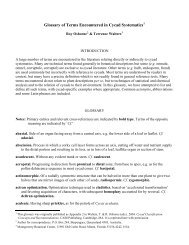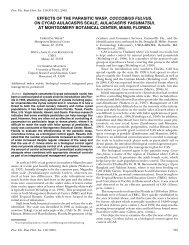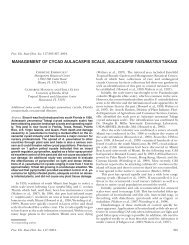Cycas-circinalis-cas.. - Cycad Specialist Group
Cycas-circinalis-cas.. - Cycad Specialist Group
Cycas-circinalis-cas.. - Cycad Specialist Group
Create successful ePaper yourself
Turn your PDF publications into a flip-book with our unique Google optimized e-Paper software.
5. Discussion<br />
5.1 Traditional fruit harvest of C. <strong>circinalis</strong><br />
The steamed fruit of C. <strong>circinalis</strong> continues to be a traditional food for many<br />
indigenous communities in the NBR, particularly those who still have close access to<br />
wild populations. The fruits of other <strong>Cy<strong>cas</strong></strong> species elsewhere are also reported to be<br />
eaten after steaming, boiling or fermentation (Thieret 1962; Whiting 1962). These<br />
processes remove the toxins. The NBR communities we interviewed were aware of the<br />
importance of removing the toxins before consumption, commenting that failure to do so<br />
would make one lose consciousness.<br />
The population structure and density analyses of fruit-harvested populations<br />
suggest that fruit harvest, even at the levels harvested for local medicinal commercial<br />
trade in Kerala, appears to have little negative impact on rates of regeneration. Heavy<br />
seed harvest has also been shown to have little impact on population growth of other<br />
cycads (Raimondo and Donaldson 2003), and other tropical tree species (e.g. Ratsirarson<br />
et al. 1996; Zuidema and Boot 2002). However, humans are not the only consumers of<br />
C. <strong>circinalis</strong> seeds, and very heavy fruit harvest could have an impact on the bats who are<br />
reported to disperse the seeds.<br />
5.2. Leaf harvest of C. <strong>circinalis</strong><br />
The steamed young leaves of C. <strong>circinalis</strong> also continue to be a traditional food in<br />
NBR communities. The young leaves of other <strong>Cy<strong>cas</strong></strong> species are reported to be consumed<br />
in South and South East Asia as well (Whiting 1962). The intensity of this harvest<br />
appears to be much less, however, than that of the commercial harvesting of mature<br />
leaves for the floriculture market. The harvest of mature leaves from Tamil Nadu for the<br />
market appears to be quite prevalent as all populations encountered in Tamil Nadu were<br />
harvested for mature leaves. In addition, harvest levels were extremely high in terms of<br />
both the percent of individuals harvested per population and of the percent of leaves<br />
harvested per tree. The lack of tenure associated with C. ciricinalis in NBR communities<br />
likely facilitates the harvest of mature leaves and pith by groups of outside harvesters.<br />
The trade channel for NTFP in Tamil Nadu can be broadly classified as gatherercontractor-big<br />
contractor- wholesaler-retailer (Samraj 2002). The fact that these<br />
harvesters have not moved in to Kerala suggests that currently the availability of C.<br />
<strong>circinalis</strong> leaves in Tamil Nadu can still meet the market demands.<br />
This heavy leaf harvest appears to be negatively impacting C. <strong>circinalis</strong><br />
populations. Our ecological results indicate that fruit and leaf harvested populations<br />
appear to have reduced rates of regeneration and, likely, elevated mortality of older<br />
individuals as a result of consistent leaf-harvest over time. This is consistent with<br />
research on leaf harvest of other species such as palms, where heavy leaf harvest leads to<br />
decreased reproductive output (Ratsirason, Silander & Richard 1996; Flores & Ashton<br />
2000; Endress, Gorchov & Noble 2004). As with other species (Whitham et al. 1991), C.<br />
<strong>circinalis</strong> may be able to allocate the stored resources it holds in its stems to growth and<br />
reproduction after defoliation. This could allow for sustained rates of growth and<br />
21






